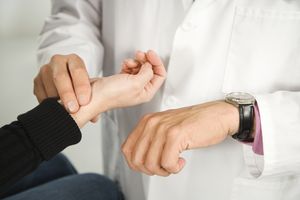Doug Heady is a competitive man. So competitive, says wife Kathy, “he can’t just do something; he has to race it.”
“It’s my lifestyle,” Heady notes proudly. And he has the titles and trophies to prove it.
An elite-level runner, cyclist and skier, Heady has worn a heart rate monitor for nearly three decades to keep an eye on his body’s response to athletic training.
So when he began to experience a faster heart rate and palpitations just over two years ago while training for the cross-country ski-racing season, the 60-year-old took notice.

Worrisome heart symptoms
After the palpitations became more frequent last summer, Heady made an appointment with his primary care physician, who ordered a treadmill stress test to record Heady’s heart rate.
“Toward the end, my heart went out of rhythm and they stopped the test,” he recalls. “My primary physician then advised me to see a cardiologist for a heart arrhythmia.”
The Ann Arbor, Michigan, resident chose Michigan Medicine, where a fellow skier had recently been treated for an arrhythmia condition.
Heady, a former University of Michigan diabetes researcher and information technology specialist, saw sports cardiologist Eugene Chung, M.D., at the U-M Frankel Cardiovascular Center.
“Dr. Chung had a pretty good idea of what my problem was after looking at the heart rate data from my stress test,” Heady says. “But he still wanted to do more testing to rule out any other issues.”
These included electrocardiograms, echocardiograms and chest X-rays. Heady also wore a recording heart rate monitor, known as a Zio patch, for 14 days.
Athletes and atrial fibrillation
Data from the tests confirmed paroxysmal atrial fibrillation, an irregular heartbeat that in Heady’s case was triggered by intense exertion and typically stopped when the exertion ended.
Atrial fibrillation originates in the heart’s upper chambers, affecting blood flow to the heart muscle and the rest of the body. Heady says he discovered that long-term cross-country ski racers often develop the type of atrial fibrillation he had.
Chung agrees, pointing to research that finds elite athletes – especially those in middle age – often are at increased risk of disturbed heart rhythms, despite their high fitness level.
The reason? “Increased cardiac output in this population can result in an enlarged and weakened heart chamber,” Chung says. “This can lead to atrial fibrosis and atrial fibrillation.”
Atrial fibrillation treatment options
Chung offered his patient several treatment options, including medication to help reduce the palpitations.
“But the medication would also lower my maximum heart rate,” Heady says. “As an athlete, I didn’t want that to happen.”
Another option was catheter ablation, a minimally invasive procedure intended to potentially cure atrial fibrillation without major surgery.
Catheter ablation features a specially designed catheter positioned in the left atrium that can deliver freezing energy (cryo) or heat energy (radiofrequency) to cauterize the area of the heart where the atrial fibrillation originates.
“After much thought and study, I chose the cryoballoon ablation procedure,” says Heady, noting that his arrhythmia was becoming “pretty dramatic.”
“When Dr. Chung asked if this was impacting my quality of life, that’s when I knew I wanted to go ahead with the procedure,” Heady says. “I really appreciated his support and knowledge of athletes. He made me feel very comfortable.”
During cryoballoon ablation, the physician threads a catheter from the femoral vein in the groin to the pulmonary veins of the heart’s left atrium, then inserts the cryoballoon catheter.
The balloon, filled with liquid nitrogen, is then inflated, causing any tissue that it touches to become frozen, or scarred. The affected tissue can no longer trigger the electrical currents responsible for atrial fibrillation.
Chung says cryoballoon ablation offered Heady a shorter procedure that would precisely reach the nerve connections in the pulmonary veins that triggered his type of atrial fibrillation.
Making strides again
The ablation, performed in February, “went well,” Chung says. “Mr. Heady is off of all anti-arrhythmic medications, and there is no detectable atrial fibrillation on his recent ECG monitor.”
After one week of no heavy lifting or exercise, Heady gradually added activities to his daily routine. Today, he’s back to training for the cross-country ski-racing season.
His strategy is to do a variety of activities: canoeing for upper-body strength, biking for lower-body strength, running for all-over cardiovascular health and specific dryland training, including roller skiing (an off-snow equivalent of cross-country skiing) and hill bounding (a strength-building workout).
“I have no arrhythmia now,” Heady says, thankful for the success of his procedure. “I knew with the ablation I might not be able to compete like before, but I had one overnight hospital stay following the procedure and have worked back to a strong fitness level. It’s quite remarkable.”



